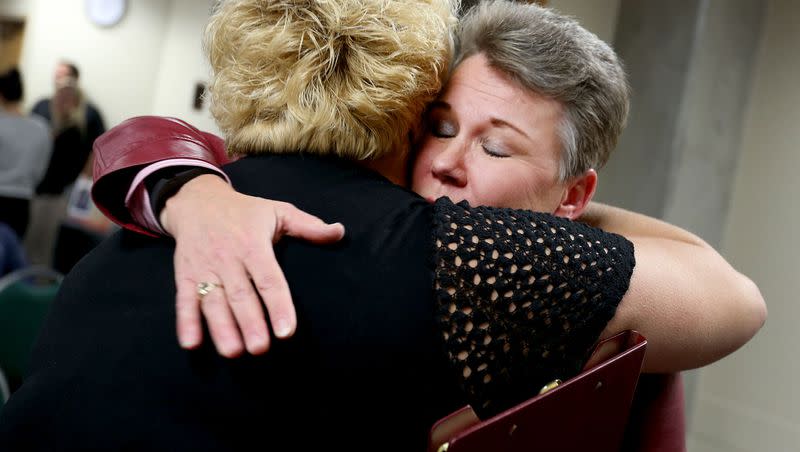Opinion: A burden shared is a burden lifted

“The pain here is palpable,” said Carrie Moore, whose husband died in a plane crash in 1996 and who was presenting at last weekend’s first-ever “Life After Loss” conference at BYU. The pain was palpable. And so was the relief at not being alone in that pain, at least for those two days.
Over and over, I heard presenters and participants say they felt so lonely while going through deep loss. That mirrors my experience as well — grief is isolating. It’s hard to talk about the nights spent collapsed on the floor, sobbing until your eyes burn and your throat is scraped raw, especially when life continues in other ways — kids still need to be fed, jobs need to be returned to and somehow, our society thinks there is a timeline for “getting over” major losses.
Grief, as participants well knew, also impacts brain function. One presenter said our brains function at about 30% for a while after deep loss. That brain fog meant for me that it took more than an hour to choose a necklace for our 5-year old daughter to be buried in when she died in 1995. I just stood at the jewelry counter in the mall, staring at my choices, unable to decide. I couldn’t decide if I should bury my daughter with a diaper on or a pair of underpants, because her Down syndrome meant she hadn’t yet mastered potty-training. Brain fog also meant that I couldn’t think of what to feed my surviving children beyond macaroni and cheese and cereal. I couldn’t decide what to wear day after day, so I defaulted to sweats and a ponytail, not just in 1995, but every time we’ve lost children.
For me, the grief process did not get easier when we buried another daughter in 2005 and another one in 2009 and yet another one in 2011, all daughters with disabilities that eventually took their lives. In fact, I think multiple losses have scarred me in ways that I can’t seem to change. I am low-key terrified every day that I will lose another child. I even check the dog to make sure he’s still breathing when he sleeps a little too deeply. I know with my head that the terror isn’t rational, but it doesn’t matter. My heart doesn’t know it. I was not the only one at that conference with multiple losses — and hearing others describe their heartache and their journey through grief made me feel less alone.
Related
The stories of people there looking for solace were unimaginably heartbreaking — stories of suicide, losing children and grandchildren to domestic violence, accidental deaths, the sudden heart attack of a relatively young spouse, the anticipated death of a loved one with a terminal diagnosis, the loss of a parental relationship that “should have been” but wasn’t because of childhood abuse and so many more. Some participants wore stickers that named the person that they lost. Everywhere, there were tears. Sacred, holy tears.
One of the keynote speakers at the conference was Melissa Dalton-Bradford, who lost her oldest son, Parker Bradford, in 2007 and earlier this year, her father. She described some of her slog through grief, and the power of solitude, spirit and service in her healing journey. As she went into the wilderness and bewilderment of grief, she found that while wilderness can be barren and scary, it can also be a place of transformation. Those of us who grieve aren’t meant to stay in the wilderness, but to (eventually) move through it. I am thankful every day for the healing power of time — and the many other ways that are helpful in that healing.
I met people for whom their major loss was recent (and by recent, I mean within the last year). Some I talked to were looking for something — anything — to ease today’s pain. With my first major loss, I looked for a checklist. If I can do A, B, and then C, I will be “over” the loss. ’Twas not to be. Grief doesn’t work that way.
Today, I know that there is no checklist for sorrow and grief. It’s never truly “over” but it does get better. Losses that have been mourned before can be, and often are, mourned again, but at some point, they no longer dominate every waking moment. I cried all weekend — for my girls, for other deep losses in our family and as a witness to the pain of others’ deep sorrow. But I also felt lifted and lightened because, I believe, a burden shared is a burden eased.
Holly Richardson is the editor of Utah Policy.

